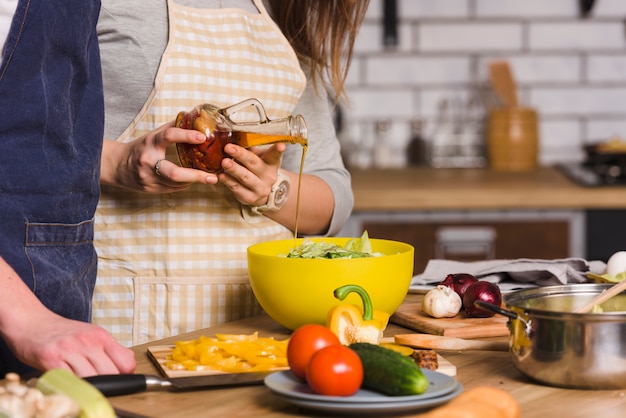You know that feeling when you're staring at a whole roasted chicken, basking in the golden glow of its crispy skin, and all you can think about is the deliciousness that awaits? But what about those little bits and bobs tucked inside, the giblets? Often relegated to a plastic bag, these seemingly unassuming parts hold a world of flavour just waiting to be unlocked. Don't be fooled by their unassuming appearance – giblets are a culinary treasure, capable of transforming a simple meal into something truly special.
Honestly, I've been there, standing in the kitchen, staring at those giblets with a bit of apprehension. "What on earth am I going to do with these?" I'd think. But over the years, I've learned to appreciate their unique qualities and discovered how to transform them into culinary gems. I'm not talking about fancy, complicated recipes here, just simple techniques that elevate the humble giblet into something truly delightful.
So, grab your apron, gather your ingredients, and let's embark on this journey together. We'll explore the wonderful world of giblets, from understanding their individual personalities to mastering the art of cooking them. Get ready for delicious stews, rich sauces, and even decadent p??tés – the possibilities are endless!
Part 1: Delving into the World of Giblets

Unveiling the Mystery of Giblets
Think of giblets as the hidden treasures of the chicken, a package of internal organs that add depth and flavour to any dish. Typically, you'll find a mix of liver, heart, and gizzards, sometimes accompanied by the neck. These little pieces may not look like much, but they're packed with flavour, a little like a secret ingredient waiting to be discovered.
Exploring Each Giblet:
Let's get to know each member of the giblet crew:
- Liver: Think of the liver as the delicate soul of the giblet family. It's incredibly tender with a rich, almost gamey flavour that's perfect for p??tés and terrines. The liver adds a touch of richness and depth that's hard to resist.
- Heart: The heart, while a bit tougher than the liver, boasts a unique, earthy flavour that's truly satisfying. It's a real workhorse in the kitchen, adding complexity to stews and soups.
- Gizzards: These muscular stomachs of the chicken pack a punch when it comes to texture. They're chewy and add a delightful crunch to dishes. Chopped and cooked into stews, sauces, or even stuffing, they bring a distinct element to your meal.
- Neck: Often included with the other giblets, the neck is a lean and versatile piece. It's perfect for adding flavour to soups and broths, enriching the base with its chickeny essence.
Part 2: Taming the Giblets: Preparation is Key

A Clean Slate: Preparing Your Giblets
Before we get to the cooking fun, let's give those giblets a little TLC. You'll usually find them in a bag, often with a bit of liquid. Rinse them thoroughly under cold water, removing any loose bits or debris. Now, for a personal touch, some like to remove the skin from the heart and gizzards, but I find the skin adds a bit of extra flavour and texture, so it's totally up to you!
Tender Loving Care for the Liver:
The liver, being the most delicate of the bunch, deserves a bit of extra attention. Gently slice it in half lengthwise, keeping an eye out for any dark spots or veins. If you find any, simply trim them off, making sure the liver is pristine for your culinary creations.
Part 3: Unveiling Giblet Delights: Delicious Recipes

Giblet Stew: Warmth in a Bowl
There's nothing more comforting than a steaming bowl of giblet stew, especially on a cold day. It's a simple dish that brings together the hearty flavours of the giblets with the warmth of vegetables and broth. Here's my tried and true recipe:
- Prep is Key: Chop your giblets into bite-sized pieces, ready for the next steps. Then, in a large pot, sauté some onions, carrots, and celery until they become soft and fragrant. This creates a delicious base for your stew.
- Searing the Flavour: Add the giblets to the pot and brown them on all sides. This step is crucial for developing a rich, caramelized flavour. Season generously with salt, pepper, and a sprinkle of thyme for a touch of earthy goodness.
- Simmering to Perfection: Pour in a can of diced tomatoes, adding a burst of acidity and sweetness. Add enough chicken broth to cover the giblets, creating a simmering liquid. Bring the stew to a boil, then reduce the heat and let it simmer for about an hour, or until the gizzards become tender.
- Final Touches for a Heavenly Bowl: Stir in some chopped parsley for a fresh touch and a dollop of sour cream or crème fra??che just before serving. The creamy richness complements the earthy flavours of the stew beautifully.
This stew is truly irresistible with a side of crusty bread for dipping and a scoop of mashed potatoes for a comforting finish. It's the perfect dish for a cozy night in.
Giblet Gravy: The Ultimate Chicken Complement
Let's be honest, what's a roast chicken without a delicious, flavourful gravy? Giblet gravy is a game-changer, adding a depth of flavour that takes your roast chicken to a whole new level. Here's how I create this culinary masterpiece:
- Giblet Base: While your chicken is roasting, gently sauté the chopped giblets in a pan with butter and olive oil. This creates a base for your gravy, extracting all those rich flavours.
- Thicken It Up: Add a couple of tablespoons of flour to the pan and cook for a minute or two, stirring constantly. The flour will thicken the gravy, creating a luscious consistency.
- Chicken Broth Infusion: Slowly whisk in some chicken broth, making sure to scrape up any browned bits from the bottom of the pan – those bits are pure flavour! Simmer the gravy until it thickens, adding more broth if needed.
- Finishing Touches: Strain the gravy through a fine-mesh sieve to remove any giblet bits, creating a smooth and elegant finish. Season with salt, pepper, and a pinch of herbs like rosemary or thyme for a hint of freshness.
Now you've got a gravy that's rich, full of flavour, and truly special – the perfect accompaniment to your roasted chicken.
Giblet P??té: A Delectable Bite
If you're feeling adventurous, why not try making a giblet p??té? It's a bit more involved than the stew or gravy, but it's a culinary adventure worth taking. Here's my recipe:
- Giblet Symphony: Gently simmer the giblets in chicken broth for about 30 minutes, or until they become tender. This process extracts their flavour and creates a base for the p??té.
- Blending into Perfection: Once the giblets have cooled, combine them with butter, cream, and seasonings – salt, pepper, thyme, and maybe a touch of nutmeg for extra warmth – in a food processor. Pulse until you achieve a smooth, creamy texture, creating a luxurious p??té.
- Resting for Flavour: Spoon the p??té into a ramekin or terrine dish. Cover it with plastic wrap and refrigerate for at least 2 hours, or overnight. This allows the flavours to meld and intensify.
Serve your giblet p??té with crusty bread and a dollop of mustard. It's an impressive appetizer that will surely wow your guests and become a culinary conversation starter.
Part 4: Giblet Wisdom: Tips and Tricks for Success
Over the years, I've learned a few tricks of the trade that make cooking with giblets a breeze:
- Wine: The Secret Ingredient: If you're making a stew, adding a splash of red wine can add a depth of flavour and help to tenderize the gizzards. The wine adds a hint of complexity and elevates the entire dish.
- Don't Overdo It: Giblets, especially the liver, can become dry if overcooked. Keep a watchful eye on them and remove them from the heat as soon as they're tender.
- Embrace Simplicity: Don't feel the need to overcomplicate things. Giblets are delicious on their own, so don't be afraid to keep your recipe simple. Sometimes, the most straightforward approach yields the most rewarding results.
- Experimentation is Key: Giblets are a culinary blank canvas, inviting you to explore different flavours and combinations. Don't be afraid to experiment and find what you love most.
Part 5: FAQs: Answers to Your Giblet Questions
1. Can I Freeze Giblets?
Absolutely! You can freeze giblets for up to 3 months. Wrap them tightly in freezer-safe plastic wrap or foil, and thaw them in the refrigerator overnight before cooking. This way, you can have giblets on hand whenever you need them.
2. Are Giblets Good for You?
Yes, giblets are a great source of protein, iron, and other essential nutrients. They're also a good source of vitamin B12, which is important for energy production and cell growth. So, not only are they delicious, but they're good for you too!
3. What If I Don't Like the Taste of Giblets?
No worries! If you're not a fan of giblets, you can always use other chicken parts like thighs or drumsticks in your recipes. But I encourage you to give them a try! You might be surprised by how much you enjoy them.
4. Can I Use Giblets in Other Dishes?
Absolutely! Giblets are versatile and can be used in a variety of dishes. Think about adding them to stuffing, soups, or even pizzas. Let your creativity run wild and experiment with different flavours and textures.
5. Is it Okay to Eat Giblets Raw?
No, it's not! Giblets, like any meat, should always be cooked thoroughly to kill any harmful bacteria. Eating raw or undercooked giblets can make you sick. Always prioritize food safety and cook your giblets until they're cooked through.
Part 6: Giblet Adventures: Global Flavour Explorations
Giblets are a culinary staple in many cultures around the world, each with its own unique way of preparing them. Here are a few examples to inspire your culinary journey:
1. French Giblet P??té (P??té de Foie de Volaille):
This classic French p??té, made with chicken liver, butter, and brandy, is a testament to French culinary expertise. It's rich, flavourful, and perfect for a special occasion or a decadent treat.
2. Italian Giblet Stew (Spezzatino di Viscere):
This hearty Italian stew, made with chicken giblets, tomatoes, onions, and herbs, embodies the essence of Italian comfort food. It's a satisfying dish that warms the soul and brings people together.
3. Filipino Giblet Soup (Sopas):
This popular Filipino soup, made with chicken giblets, vegetables, and noodles, is a culinary symphony of flavours. It's a comforting and nourishing dish that's perfect for any meal, bringing warmth and satisfaction.
Part 7: The Giblet Challenge: A Culinary Adventure
Here's a fun challenge: try incorporating giblets into a dish you wouldn't typically think of. It could be a stir-fry, a salad, or even a quiche. Be creative and let me know how it turns out! I'm always eager to hear about your culinary adventures.
Part 8: A Culinary Journey Concludes: The Magic of Giblets
So, there you have it, a comprehensive guide to cooking giblets, from understanding their unique flavours to mastering the art of preparing them. It's a journey of flavour, texture, and culinary adventure. Don't be afraid to experiment, embrace the unexpected, and remember that even the most humble of ingredients can create dishes that are both delicious and memorable. Happy cooking!
Everyone is watching

How to Cook Frozen Lobster Tails Perfectly: A Step-by-Step Guide
RecipesLobster. Just the word conjures up images of lavish meals, special occasions, and a taste of luxury. But let's...

Pigs in a Blanket Cooking Time: How Long to Bake for Perfect Results
RecipesAh, pigs in a blanket. Just the name conjures up images of those delightful little parcels of crispy pastry en...

Pork Fillet Cooking Time: How Long to Cook It Perfectly
RecipesPork fillet, or tenderloin as it's sometimes called, is a real favourite in our house. It's so versatile, and...

The Ultimate Guide to Tender, Juicy Pulled Pork
RecipesRight, let's talk pulled pork. It's one of those dishes that just screams "comfort food," doesn't it? I mean...

The Ultimate Guide to Cooking Sweet Potatoes: From Roasting to Mashing
RecipesSweet potatoes. Just the name conjures up images of warm, comforting dishes, bursts of vibrant color, and a to...
